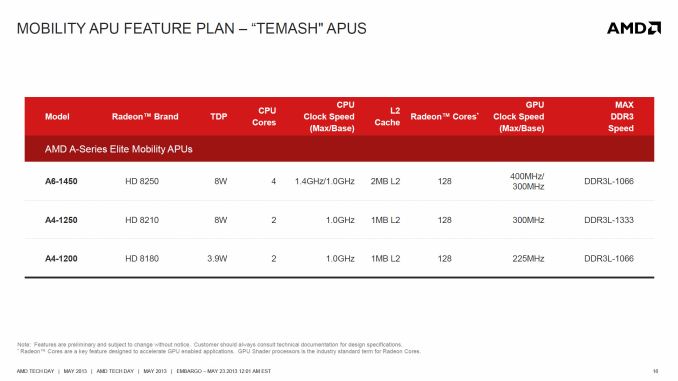AMD’s 2013 Elite Mobility Platform, aka Temash
by Jarred Walton on May 23, 2013 1:23 AM EST
AMD has a bunch of APUs launching today, and while the only hardware we have on hand for testing right now consists of a Kabini laptop, we wanted to at least briefly discuss the two other APUs. Temash is essentially the same APU as Kabini, only with a lower TDP target, which also means reduced clock speeds. Where Kabini is destined for ultraportable laptops and hybrid devices, or perhaps a larger tablet, Temash is very much targeted at “true” tablets. The Temash family currently consists of three APUs with three different TDPs:
At the top of the product stack is the A6-1450, a true quad-core APU with a 1.4GHz maximum Turbo Core clock and a base 1.0GHz clock. It has an 8W TDP, and like all of the currently announced Kabini/Temash parts it features a GCN-based GPU with 128 Radeon cores. Clock speeds on both the CPU and GPU are lower than the A4-5000M Kabini we looked at today, but in the world of tablets the A6-1450 should prove quite formidable. What’s interesting (or perhaps “odd” is a better word) is that the A6-1450 may have a lower TDP than the next APU, the A4-1250.
The A4-1250 drops to a dual-core CPU and skips out on Turbo Core. With those two changes, one would expect it to consume less power than the A6 model, but it ends up at the same 8W. (Note: I have another slide from AMD that shows 9W; this might simply be a typo, but the above slide shows 8W.) That could mean the A4-1250 is either die-harvested or, more likely, it’s from a part of the wafer that wasn’t able to reach the TDP/clock speed requirements to be in a lower power part. I’d guess that the A4-1250 shouldn't have to throttle much, but we'll see.
The final chip is the same configuration as the A4-1250, but the A4-1200 has a reduced GPU clock and it has a 3.9W TDP. This is the chip that will go up against the current fastest ARM SoCs like Apple’s A6 in the 4th generation iPad 4 and Qualcomm’s Krait. Based on what we’ve seen from Kabini, at 225MHz the A4-1200 should be roughly comparable to the A6 GPU, though Apple has of course been shipping for a while now whereas we’ve yet to see a Temash tablet.
AMD provided the usual collection of marketing material, which we’ve included in the gallery below.

















12 Comments
View All Comments
testbug00 - Thursday, May 23, 2013 - link
One, this is just bad naming.two, i meant to make an account to say this forever ago, but this version of the website runs slow as hell (compared to the old one) on my iphone4.
testbug00 - Thursday, May 23, 2013 - link
just to clarify the bad naming, i mean for Temash and Kabini together have horrible naming....xdrol - Thursday, May 23, 2013 - link
I hope you are aware that these are just codenames, AMD never brings these items to the market under these names.testbug00 - Friday, May 24, 2013 - link
i mean the A4/A6 names, currently used by Temash, Kabini and Trinity/Richlandvarad - Thursday, May 23, 2013 - link
Jarred,I'm not sure where you got the 9W TDP from. The slide seems to mention both A6-1450 & A4-1250 as having a TDP of 8W. Also, the A4-1250 seems to support higher max memory clock speeds. This could be why the TDP is similar despite dropping 2 cores and skipping turbo.
JarredWalton - Thursday, May 23, 2013 - link
Ha! I have a second set of images from AMD that distinctly shows 9W on the A4-1250. I wonder which one is correct? Here's the link to the "9W" image:http://images.anandtech.com/doci/6978/image004.png
varad - Thursday, May 23, 2013 - link
That is weird. For reference, do we know what the TDP is for android tablets such as the Nexus 7 and 10?JarredWalton - Thursday, May 23, 2013 - link
I believe the SoC TDP on high performance ARM chips is right around 4W, with some going above that for short periods (8W max but only for a few seconds?)zeo - Tuesday, May 28, 2013 - link
The Tegra 4 raises it to 5W but ARM SoCs idle most of the time and can idle to very low mw states that Temash can't reach aside from entering S3 Suspend State... and ARM SoCs can also perform most tasks while still operating in low mw power levels.AMD has improved their power efficiency significantly compared to the previous Brazos but their idle states still look more like ARM maximum states...
Numbers given by AMD for example indicate that the A4-1200 APU consumes 1.2 Watt when idle, 1.4 Watt during browsing, and 2.35 Watt when playing h.264 online video at 1080p resolution. Total platform power for these types of activities is 2.8 Watt, 3.7 Watt and 5.3 Watt respectively.
Mind that ARM SoCs also integrate more components than just the primary chipsets... Qualcomm especially, since they integrate the Cellular Modem now as well...
This is one of the reasons why AMD can't offer mobile features like always connected standby... but also why they need to get below 5W to go into fan-less tablets.
So it looks like only the A4-1200 would even try to compete in that range...
MrSpadge - Thursday, May 23, 2013 - link
Why would the A4-1250 not have a turbo mode, at least for the CPU? This seems stupid, since the technology is there (see A6-1450), the performance difference to the next model is there (4 vs. 2 cores will help at something) and the power consumption headroom should be there (otherwise the A6-1450 would never be able to actually turbo up).Especially with low clocked low performance CPUs single threaded performance is king!